DNR Casts Out Lines Of Information About Webster Lake

Indiana Department of Natural Resources North Region Fisheries Supervisor Jeremy Price spoke at the August general meeting of the North Webster-Tippecanoe Township Chamber of Commerce to a larger than average attendance.
Double the normal number of attendees turned out for the Monday general meeting of the North Webster-Tippecanoe Township Chamber of Commerce at the North Webster American Legion Post 253.
The draw was a presentation by Indiana Department of Natural Resources North Region Fisheries Supervisor Jeremy Price. A general overview of weed control guidelines by the Department of Natural Resources was given. Several lake front property owners and members of the Webster Lake Conservation Association were present as well as chamber members.
Webster Lake has had a season where the lake was full of weeds above water line. Many were Eurasian watermilfoil, until recently deemed by the DNR an invasive species. Weeds were caught in boat propellers and the current and wind carried masses of weeds and debris to shore. Property owners then had to deal with the mess.
While there is no statistical study in place, it is seen by some recreational use of the area lakes by families leads to more economic growth for the community and to more people buying summer and retirement homes. This view led to the chamber’s interest.
Price started by explaining if the DNR is getting complaints from property owners, anglers and recreational users, it was viewed a fairly balanced policy was in place. Some seemed to feel as stated by summer resident Doug Moore, “Webster Lake is getting ‘over-muskiefied.’ What are we to do? We pay property taxes here but cannot vote here and so have no clout. We don’t have a state representative that is interested in us or a lobbying organization. Weeds continue to expand and clog complete areas of the lake.”
The term “over-muskiefied” refers to the practice put in place by the DNR in 1986 of Webster Lake becoming the nursery and breeding grounds for all the muskie fish supply that go in state owned lakes. According to one long time resident, when that occurred, there were so many blue gills in the lake it made swimming impossible. Muskie is a blue gill predator.
Several comments were made there needs to be a balance between anglers, property owners and the area’s economic growth needs. Some people seemed to feel the anglers had an upper hand.
Price showed the formula used for weed control application approval is based on data from the DNR and the aquatic control firms. “For the past few years, the DNR has been implementing review process guidelines. If one of the variables doesn’t trigger a ‘yellow flag’ then the application is approved by the state biologist, LARE or lakes, streams and rivers staff and upper level DNR staff. These guidelines are continuing to be developed,” he explained.
Guidelines are based on percentages of different types of areas to be treated including total surface acreage, littoral zones where plants can grow and shoreline length. Glacial cool water lakes like Webster Lake have different percentages than other types. There are 774 acres in Webster and Backwater lakes and they are considered as one by the DNR.
At the conclusion of the almost one and half hour presentation, Price and the WLCA representatives agreed to meet in October to work together to come up with solutions. He was told by audience members he brought much new information to light and they were thankful for his presentation.
Price can be contacted at his office in Columbia City by phone at 260-244-6805, extension 6805 and he can be reached by email, [email protected].
